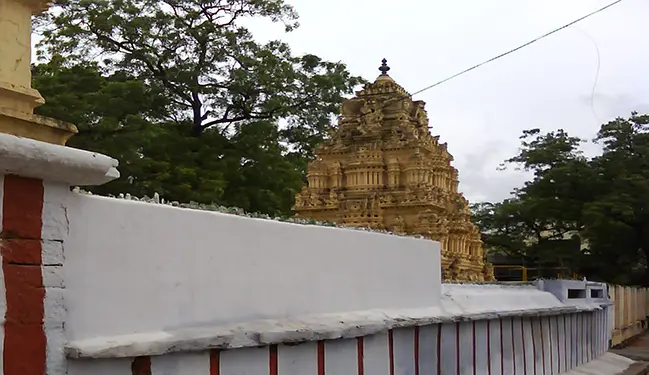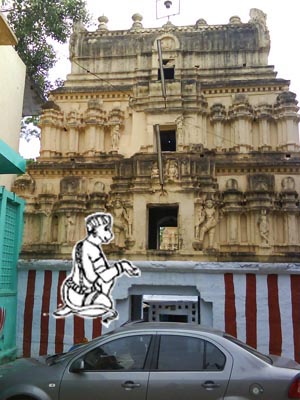
Cuddapah alias Kadapa
Kadapa was ruled by Cholas, Kakatiyas and then it came under the Empire of Vijayanagar in the latter half of the 14th century. The region was under the control of Gandikota Nayaks, governors of Vijayanagar for two centuries. The region was brought under the Nawab of Golkonda in the year 1565 by when Mir Jumla defeated the Nayaks. Later the British took control of Kadapa in the year 1800. Except for some years in the beginning, Kadapa was the seat of the Mayana Nawabs in the 18th century, but with the British occupation, it became the headquarters of one of the four subordinate collectors under the principal collector by the name of Major Munro.
Cuddapah city is situated eight km south of the Penna River, the city is surrounded on three sides by the Nallamala and Palakonda hills. Cuddapah derived its name from the word ‘Gaddapa’ which means entrance or doorway in Telugu. To have the darshan and blessings of Lord Venkateswara of Sri Sheashatrishyla, Cuddapah was the entrance and hence known as Devuni Caddapah, later came to be known as Cuddapah.
Cuddapah and Anjaneya
We had seen one of the interesting Anjaneya temples near Cuddapah in the villageVempalle, known popularly as Gandi kshetra in the valley formed by Palakonda hills. There is an ancient temple for Lord Anjaneya in Cuddapah town itself. The temple is located in Bharmin Street in Cuddaph, which is nearly three kilometers from the railway station & central bus station and one kilometer from the old bus station.
The Anjaneya temple
 The imposing structure of the temple which is west-facing has a beautiful three-tier
rajagopuram, which has five kalasa on the top. On the left side, there is a
painting of lord Anjaneya and on the right, Sri Raghavendra is seen. There are not
much of scapulars in the Rajagopuram except one in the first tier depicting a saint
(Sri Madwacharya) seated in front of a Rishi (Sri Vyasa) and two dwara
palakas. As you enter through Rajagopuram there is an open space and on to
the right, you can see the temple well, from where pure water for abishekam
is taken. Beside the well, there is a small tulsi plant being worshiped daily in the
temple.
The imposing structure of the temple which is west-facing has a beautiful three-tier
rajagopuram, which has five kalasa on the top. On the left side, there is a
painting of lord Anjaneya and on the right, Sri Raghavendra is seen. There are not
much of scapulars in the Rajagopuram except one in the first tier depicting a saint
(Sri Madwacharya) seated in front of a Rishi (Sri Vyasa) and two dwara
palakas. As you enter through Rajagopuram there is an open space and on to
the right, you can see the temple well, from where pure water for abishekam
is taken. Beside the well, there is a small tulsi plant being worshiped daily in the
temple.
An entrance to the Anjaneya sannidhi is through the covered pathway. Now standing in the lengthwise rectangular hall one can see the Lord Sannathi. Lord's sannidhi is decorated with plantain trees on each side with a bunch of bananas hanging making this place more mangalm and pleasant.
Legend
Before we have the darshan of the Lord, let us see the legend of how this temple came into being. While Cuddapah was under the rule of one of the Nijams (ie., after 1565 AD and before 1800 AD), the ruling Nawab had a dream in which Lord Anjaneya appeared and instructed him to install HIM for proper worship. Under the divine direction, the Nawab started searching for the vigraha of the Lord in the Penna river bank and the canals there.
Nawab could locate the vigraha amid the stream, being used as a stone for washing cloth by the washermen and others. On turning the stone, to everybody's surprise Lord Anjaneya's vigraha in ardha shila form was found.
During the mangalarathi, it would appear to the devotee that Lord Anjaneya is happily swinging in joy. Therefore, the Lord of this kshetra came to be known as Jool Anjaneya, joolna in Hindi means swinging. It is said that the British collector Major Munro also had a similar experience during his visit to this temple.
Nawab then took the vigraha to the present place and got the installation done as per the rules. He also constructed the temple. For daily pooja and for upkeep of the temple he had brought some Madhwa brahmins from Padakandla village and handed over the temple to them.
But as a devotee of the Lord, he used to visit the temple every day for his enthrallment with offerings to the Lord. To his excitement during the mangalarathi, it would appear to him that Lord Anjaneya is now happily swinging in joy. From then on the Lord of this kshetra came to be known as Jool Anjaneya, joolna in Hindi means swinging.
It is said that the British collector Major Munro also had a similar experience when he visited this temple to have the darshan of Lord Anjaneya.
Lord of this kshetra
Lord Anjaneya of this kshetra is magnificent to look at, with His gigantic figure (महाकाय:). The Lord is facing west and is seen as if walking southward His raised right hand is seen giving "Abhaya". His left hand is placed on the waist holding the Sougandhiga flower, the celestial blossom. He is wearing an ear ring ("kuntala") (कुण्लदीप्तिमते). His tail is seen raised above the head and at the end folded. There is no bell at the end of the tail, which is normally found in the Vyasaraja pradishta. His quite tuft with a small knot is seen falling over His left shoulder (चञ्चलद्वालसंनद्धल्म्बमानशिखॊज्वलाया). He is seen with all ornaments like keyur in the hands and thandai in the legs. His neck is adorned with malas of three different kinds. His moustaches show Him as a great warrior and a maha veera (महा वीरा). Lord's eye is the most magnetic feature, with a lot of grace and compassion pouring in abundance. It is told by the pujari that during Lord's mangala snan (abishekam) one could see the hair in the body of the Lord.
Poojas
Apart from daily pooja, during the Dasahara days special poojas are offered to the Lord Anjaneya. Special Uthsavas are conducted during Hanumath Jayanthi and Madhwa Navami.
Experience
A visit to this ancient temple and darshan of Lord Jool Anjaneya is sure to make one's heart swing with happiness and joy, and thereby to their family.
SRI HANUMAN THINKS DIFFERENTLY, THINKS FAST
THINKS AHEAD AND ACTS FOR SURE
Ed [May 2010]
Updates: [Jan 2025]
*The author is an
officer working with LIC, Cuddapah
